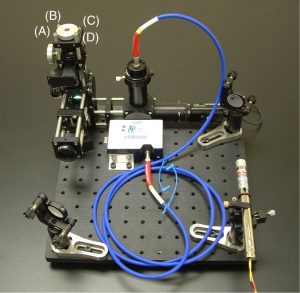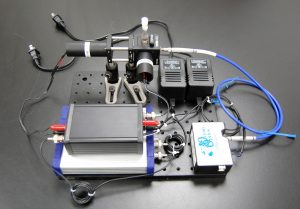DEMONSTRATION OF A LOW-COST, SINGLE MOLECULE CAPABLE, MULTIMODE OPTICAL MICROSCOPE
Abstract
 We have demonstrated the construction and use of a low-cost optical microscope capable of single-molecule detection. The instrument operates in confocal, total internal reflection, epifluorescence, and brightfield transmitted light modes. The microscope is capable of detecting the blinking of individual CdSe/ZnS core/shell quantum dots as well as the fluorescence of single solution-synthesized CdSe nanowires. Furthermore, the Brownian motion of 40-nm and 500-nm diameter dye-doped polystyrene beads suspended in water can be observed. This demonstrates a wide range of applications for the microscope within the context of an undergraduate laboratory. Modifications to the system include the addition of a fiber-based spectrometer allowing the acquisition of fluorescence spectra from selected areas of samples. The assembly and alignment of such a microscope not only shows different forms of modern single-molecule microscopy to both undergraduates and high school students alike but also provides a useful platform for studying microscopic processes at the single-fluorophore limit.
We have demonstrated the construction and use of a low-cost optical microscope capable of single-molecule detection. The instrument operates in confocal, total internal reflection, epifluorescence, and brightfield transmitted light modes. The microscope is capable of detecting the blinking of individual CdSe/ZnS core/shell quantum dots as well as the fluorescence of single solution-synthesized CdSe nanowires. Furthermore, the Brownian motion of 40-nm and 500-nm diameter dye-doped polystyrene beads suspended in water can be observed. This demonstrates a wide range of applications for the microscope within the context of an undergraduate laboratory. Modifications to the system include the addition of a fiber-based spectrometer allowing the acquisition of fluorescence spectra from selected areas of samples. The assembly and alignment of such a microscope not only shows different forms of modern single-molecule microscopy to both undergraduates and high school students alike but also provides a useful platform for studying microscopic processes at the single-fluorophore limit.
Reference
“Demonstration of a low-cost, single molecule capable, multimode optical microscope” V. Protasenko, K. L. Hull, M. Kuno, Chem. Ed. 2005, 10, 269-282.
Download Supporting Information
Movies
CONSTRUCTION & DEMONSTRATION OF A LOW COST EDUCATIONAL TRANSIENT ABSORPTION SPECTROMETER
Abstract
 We describe the construction and use of a low-cost light-emitting diode (LED)-based transient absorption spectrometer. Both the pump and the probe in the instrument are high power LEDs which replace more costly flash lamps or lasers used in prior educational transient absorption systems. Apart from cost, the wide variety of LEDs available means that numerous excitation wavelengths are possible. Our spectrometer operates on the microsecond timescale and records transient spectra, allowing the unambigous identification of chemical intermediates. We illustrate its functionality by conducting transient absorption experiments to extract dye isomerization kinetics. Furthermore, we demonstrate its use in measuring the triplet excited state kinetics of an organic dye. The system is both affordable and portable, making it an ideal platform for teaching moder pump-probe spectroscopies to undergraduates as well as high-school students. Future upgrades to the LEDs, their drive electronics as well as detectors can increase the instrument’s time resolution and/or sensitivity.
We describe the construction and use of a low-cost light-emitting diode (LED)-based transient absorption spectrometer. Both the pump and the probe in the instrument are high power LEDs which replace more costly flash lamps or lasers used in prior educational transient absorption systems. Apart from cost, the wide variety of LEDs available means that numerous excitation wavelengths are possible. Our spectrometer operates on the microsecond timescale and records transient spectra, allowing the unambigous identification of chemical intermediates. We illustrate its functionality by conducting transient absorption experiments to extract dye isomerization kinetics. Furthermore, we demonstrate its use in measuring the triplet excited state kinetics of an organic dye. The system is both affordable and portable, making it an ideal platform for teaching moder pump-probe spectroscopies to undergraduates as well as high-school students. Future upgrades to the LEDs, their drive electronics as well as detectors can increase the instrument’s time resolution and/or sensitivity.
Reference
“Construction and demonstration of a low-cost educational transient absorption spectrometer” F. Vietmeyer, M. Kuno, Chem. Ed. 2013, 18, 196-202.
